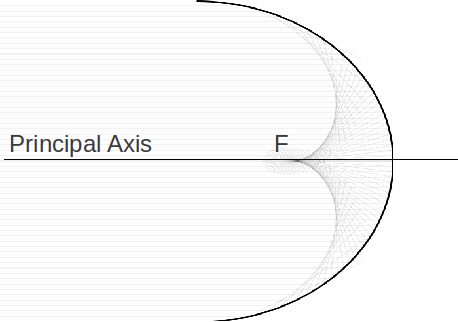Spherical Mirrors of Large Aperture
The thin lens equation![]() where
where
![]() is the focal length
is the focal length
![]() is the object distance
is the object distance
![]() is the image distance
is the image distance
only applies to spherical mirrors (or thin lenses) of small aperture. If the mirror has a large aperture, a sharp image is not formed. If a hemispherical mirror is used, a beam of light parallel to the axis intersects on reflection to form a surface called a 'caustic'.

A caustic can often be seen reflected from the surface of tea or coffee in a cup. The caustic in this case is caused when light is reflected from the inside of the cup, which acts as a mirror of large aperture. If light parallel to the principal axis has a small aperture, only those rays close to the principal axis are reflected and the small aperture approximation means theat a sharp image is formed at the point F above, called the principla focus.